#french fashion plate
Text

Fashion Details in Art
#victorian era#victorian#historical fashion#historical#vintage#art#fashion plate#french historical fashion#french fashion plate
90 notes
·
View notes
Note
I've seen a post you've reblogged and added to, among many things about women showing nipples. Can you recommend any ref material (articles, videos, etc.) are share your knowledge about this? Cause I'm curious about that, as nowadays going out in a shirt without a bra makes you indecent, while in like 90s it was okayish? I wonder how it was in previous centuries.
There is a really cool academic paper about bare breast dresses in 17th century England specifically. I think anyone can read it by creating a free account.
Abby Cox also has a good video about the cleavage during the past 500 years in which she goes through also the nip slip phenomena.
I don't have other sources that specifically focus on this subject, though many sources about specific decades touch on it, but I do have my primary source image collection, so I can sum up the history of the bare nipple.
So my findings from primary source images (I could be wrong and maybe I just haven't found earlier examples) is that the Venetians were the first ones to show the nipple for courtly fashion. At the same time in other places in Europe they sported the early Elizabethan no-boob style that completely covered and flattened the chest. In the other corners of Italy the necklines were also low but less extreme. Venetian kirtle necklines dropped extremely low as early as 1560s and they combined extremely sheer, basically see-through partlets with their kirtle. First example below is a 1565-70 portrait of a Venetian lady with the nipples just barely covered waiting slip into view with a movement of arm. There was an even more extreme version of this with the kirtle being literally underboob style, still with a sheer doublet. Though I believe this was not quite for the respectable ladies, since I have only seen it depicted on high class courtesans. They were not exactly respectable ladies, but they did have quite good social position. The second example is a 1570s depiction of a courtesan, which is revealed by the horned hairstyle. By the end of the century this underbust style with only see through fabric covering breasts, had become respectable. In the last example it's shown on the wife of the Venetian doge in 1597.
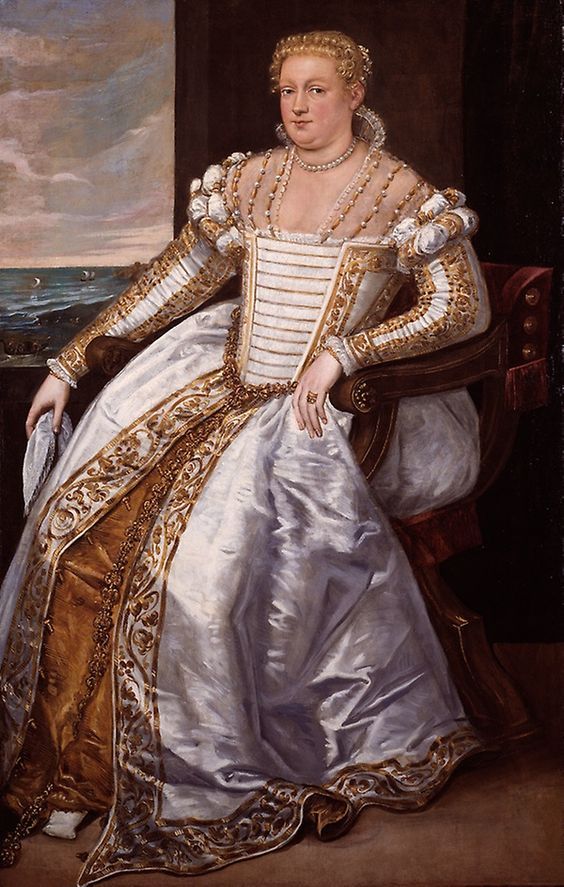
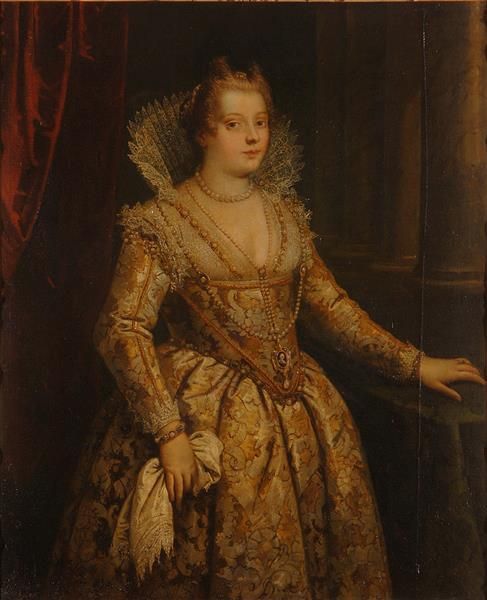

Around the same time, at the very end of 1500s, the extremely low cut bodice fashion enters rest of Europe. The low cut style was present in the bodices of all classes, but the nipple was really only an aristocrat thing. The lower classes would cover their breasts with a partlet, that was not sheer. Bare breast was ironically from our perspective a show of innocence, youthful beauty and virtue, and to pull off the style with respect, you also had to embody those ideals. Lower class women were considered inherently vulgar and lacking virtue, so a nipple in their case was seen as indecent. Bare boobs were also a sort of status symbol, since the upper class would hire wet nurses to breastfeed their children so they could show of their youthful boobs.
Covering partlets and bodices were still also used in the first decade of 1600s by nobles and the nip slip was mostly reserved for the courtly events. The first image below is an early example of English extremely low neckline that certainly couldn't contain boobs even with a bit of movement from 1597. The 1610s started around 5 decades of fashion that showed the whole boob. The first three were the most extreme. Here's some highlights: The second image is from 1619.
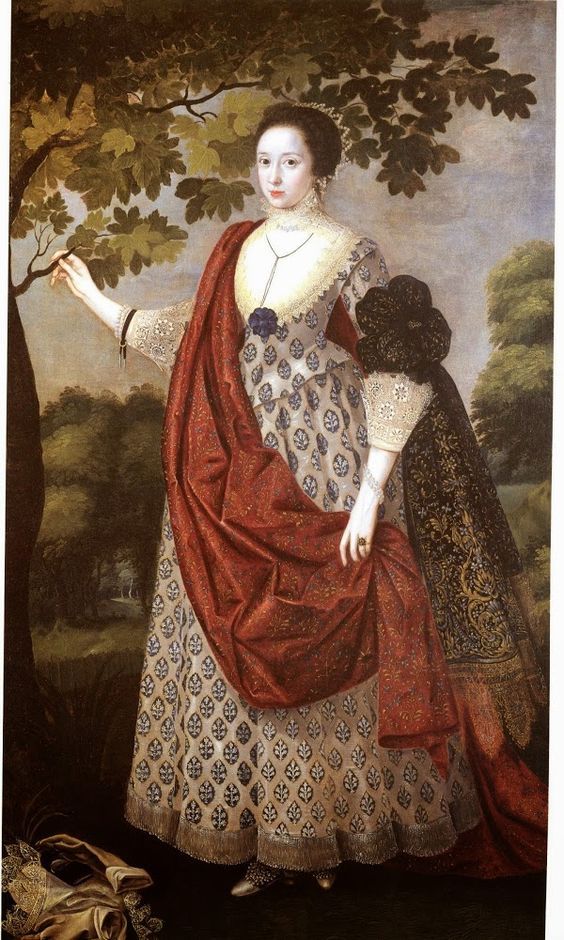

Here the first, very much showing nipples, from c. 1630. The second from 1632.
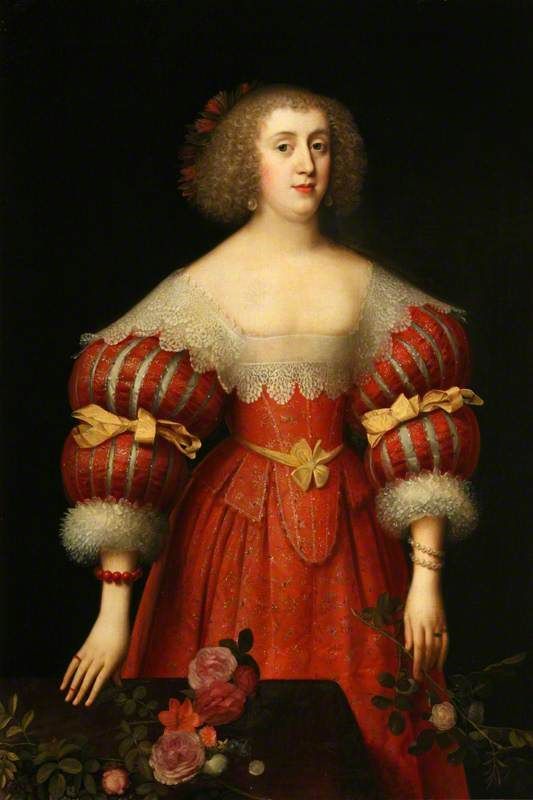
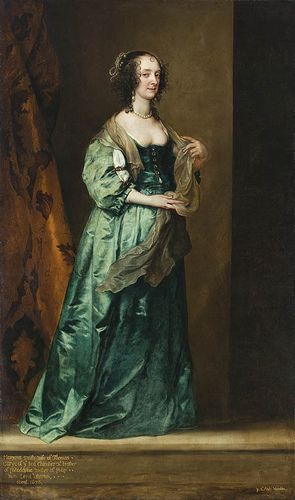
The neckline would slowly and slightly rise during the next decades, but nip slips were still expected. Here's an example from 1649 and then from 1650-55. In 1660s the neckline would get still slightly higher and by 1870s it was in a not very slippable hight. The necklines would stay low for the next century, though mostly not in boob showing territory, but we'll get there. But I will say that covering the neckline in casual context was expected. Boobs were mostly for fancy occasions. It was considered vain to show off your boobs when the occasion didn't call for it and covering up during the day was necessary for a respectable lady. You wouldn't want to have tan in your milk-white skin like a poor, and also they didn't have sun screen so burning was a reasonable concern.

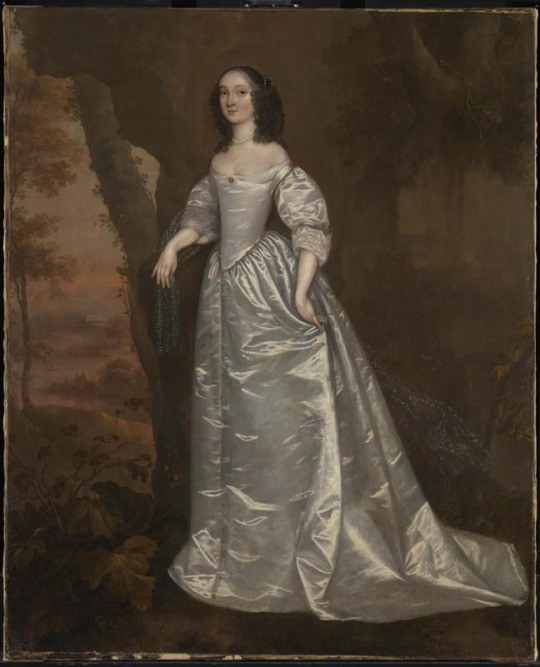
1720s to 1740s saw necklines that went to the nip slip territory, though they didn't go quite as low as 100 years earlier. The nipple was present in the French courtly fashion especially and rouging your nipples to enhance them was popular. Émilie Du Châtelet (1706-1749), who was an accomplished physicist and made contributions to Newtonian mechanics, was known in the French court to show off her boobies. An icon. Here she is in 1748. Here's another example from this era from 1728.
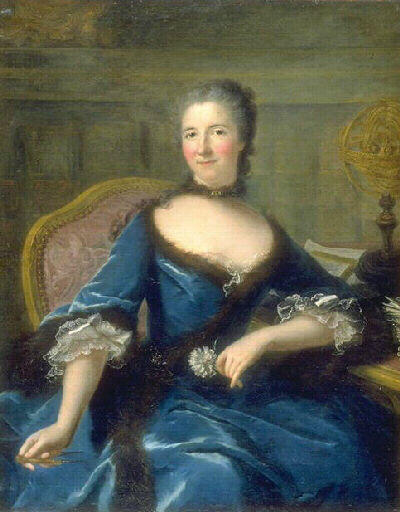
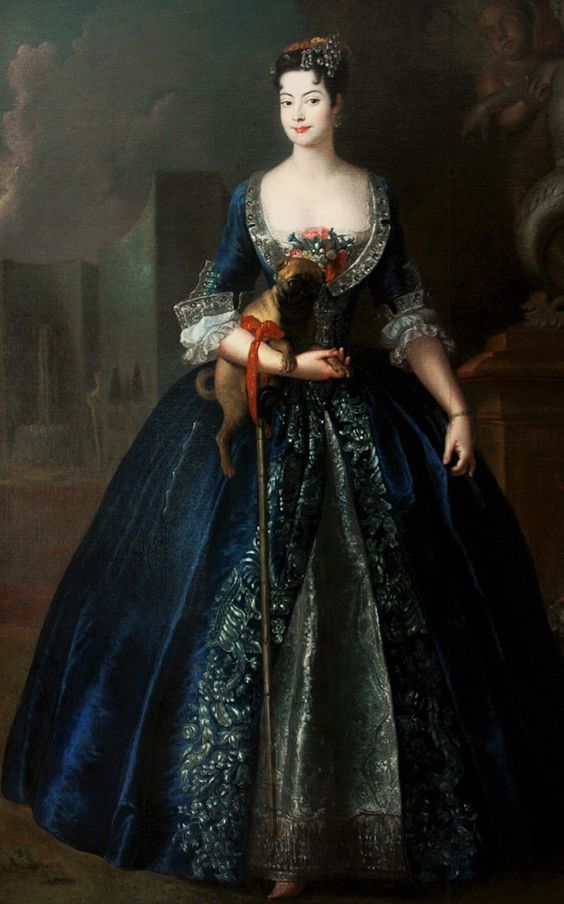
The Rococo neckline never got high, but in the middle of the century it was less low till 1770s when it plunged into new lows. In 1770s the fashion reached a saturation point, when everything was the most. This included boobs. The most boob visible. There was a change in the attitudes though. The visible boob was not a scandal, but it was risque, instead of sing of innocent and did cause offense in certain circles. I think it's because of the French revolution values gaining momentum. I talked about this in length in another post, mostly in context of masculinity, but till that point femininity and masculinity had been mostly reserved for the aristocracy. Gender performance was mostly performance of wealth. The revolutionaries constructed new masculinity and femininity, which laid the groundwork for the modern gender, in opposition to the aristocracy and their decadence. The new femininity was decent, moral and motherly, an early version of the Victorian angel of the house. The boob was present in the revolutionary imagery, but in an abstract presentation. I can't say for sure, but I think bare breasts became indecent because it was specifically fashion of the indecent French aristocracy.
Here's example somewhere from the decade and another from 1778. The neckline stayed quite low for the 1780s, but rose to cover the boobs for the 1790s.

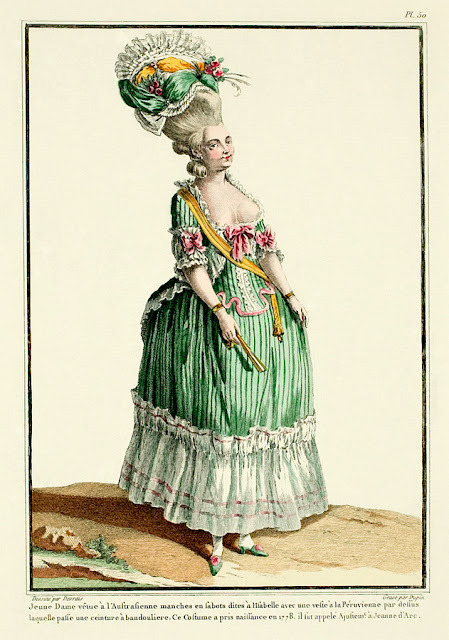
The nipple didn't stay hidden for long but made a quick comeback in the Regency evening fashion. It was somewhat scandalous by this point, and the nipple and sheer fabrics of the Regency fashion gained much scorn and satire. The styles that were in the high danger nip slip territory and those that allowed the nipple to show through fabric, were still quite popular. The sleeves had been mid length for two centuries, but in 1790s they had made a split between evening and day wear. The evening sleeves were tiny, just covering the shoulder. Showing that would have been a little too much. Like a bare boob? A risque choice but fine. A shoulder? Straight to the horny jail. (I'm joking they did have sheer sleeves and sometimes portraits with exposed shoulder.) But long sleeves became the standard part of the day wear. Getting sun was still not acceptable for the same reasonable and unreasonable reasons. Day dresses did also usually have higher necklines or were at least worn with a chemisette to cover the neckline. Fine Indian muslin was a huge trend. It was extremely sheer and used in multiple layers to build up some cover. There were claims that a gust of wind would render the ladies practically naked, though because they were wearing their underclothing including a shift, which certainly wasn't made from the very expensive muslin, I'm guessing this was an exaggeration. Especially though in the first decade, short underboob stays were fairly popular, so combined with a muslin, nipples were seen. Here's an early 1798 example of exactly that. The short stays did disappear eventually, but in 1810s the extremely small bodices did provide nip slip opportunities, as seen in this 1811 fashion plate.
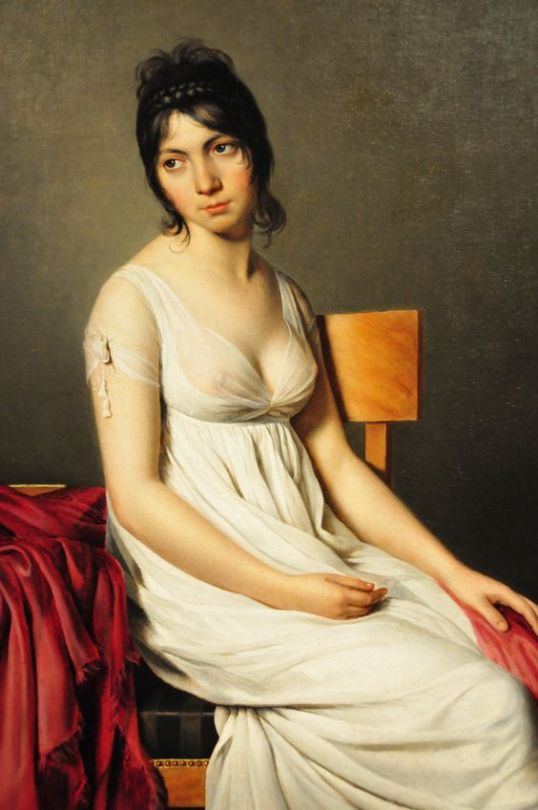
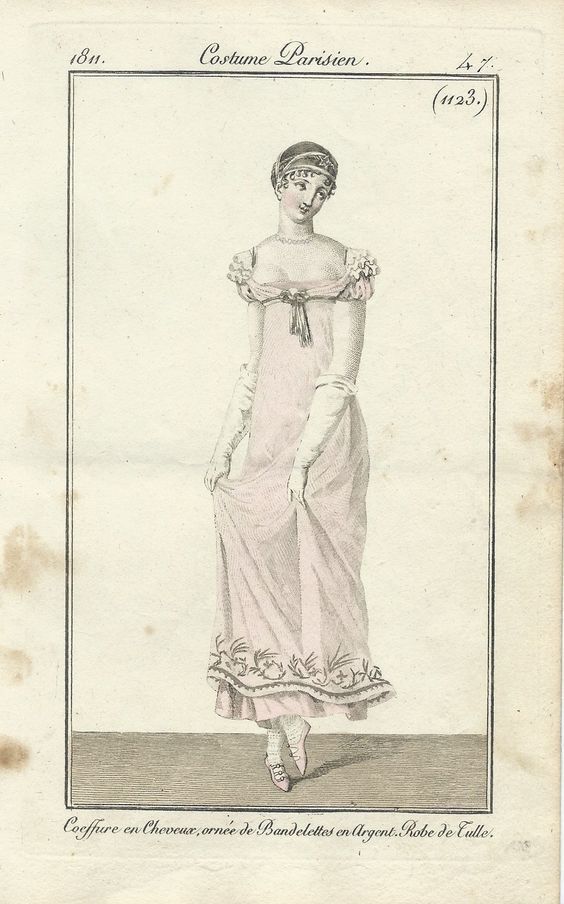
Victorian moralizing did fully kill the nip slip, though at least they were gender neutral about it. The male nipple was just as offensive to them. In 1890s, when bodybuilding became a big thing, bodybuilder men were arrested for public indecency for not wearing a shirt.
#there was also the new femininity aspect to regency nipple which had to do with breastfeeding becoming fashionable among upper class#it's about the whole motherly thing that came with the french revolution#i can't remember the book i read it from so i didn't go into it because i couldn't remember the details lol#but it did definitely have an effect to the fashion and to the perception of nipple#historical fashion#fashion history#history#dress history#fashion#answers#painting#fashion plate#renaissance fashion#elizabethan fashion#rococo fashion#baroque fashion#regency fashion#will tumblr prove itself to be again more prudish than elizabethans and label my post as mature content?#remains to be seen
504 notes
·
View notes
Text


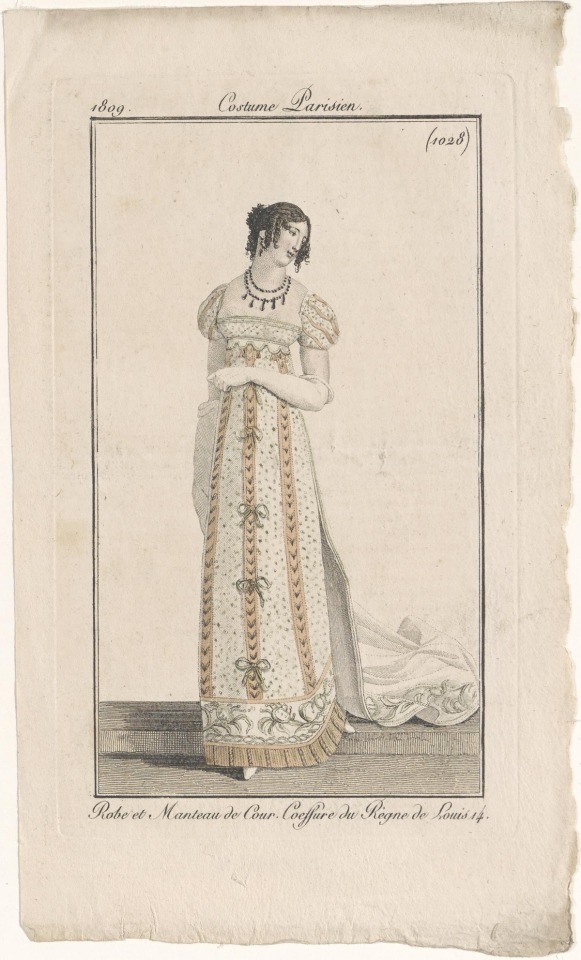


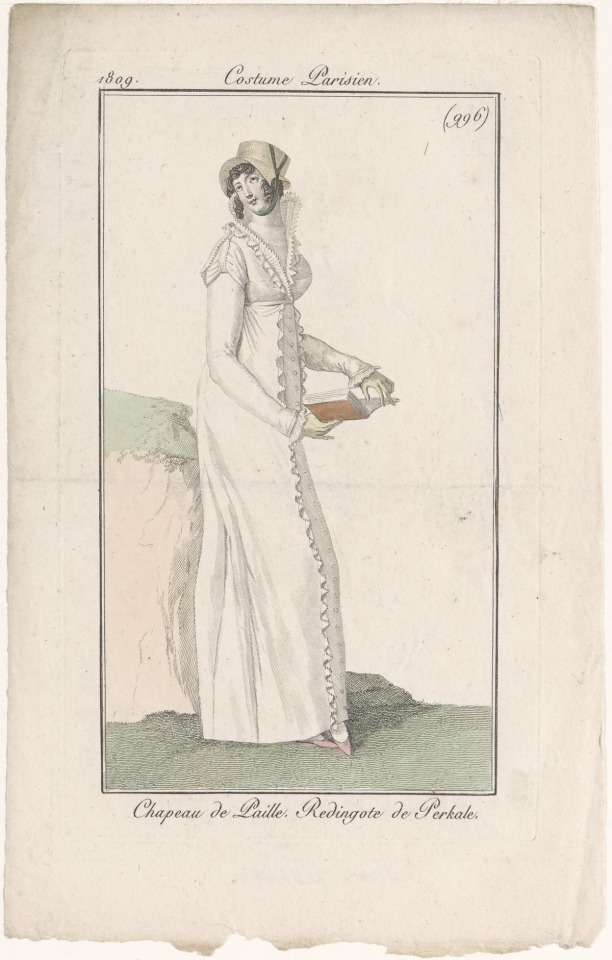
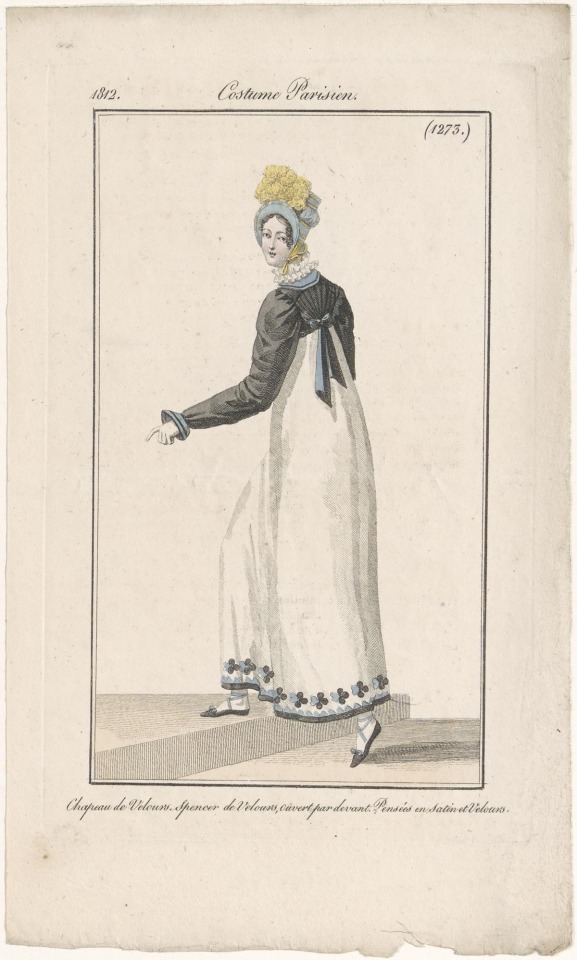

Fashion prints from Journal des Dames et des Modes
1808-1814, Napoleonic era
CMU
#fashion plates#fashion prints#prints#fashion#Journal des Dames et des Modes#Napoleonic era#napoleonic#napoleon#first french empire#napoleon bonaparte#1800s#1800s fashion#19th century fashion#historical fashion#history of fashion#art#centraal museum#Netherlands#french empire#mode#regency#regency era#regency fashion#Jane Austen#print#pretty#France#empire style#empire
250 notes
·
View notes
Text

French fashion plate, Page de Joseph Paquin, Art Gout Beaute, Feuillets de l'élégance féminine, March 1932.
#Feminine Elegance#joseph paquin#paquin#30s gowns#30s evening dresses#1932#1932 illustrations#march issue#march#fashion plate#Art Gout Beaute#french fashion#paris fashion#parisian chic#chic#fashion illustration#illustration#30s fashion#30s mode#paris mode#elegance#the back#Art–Goût–Beauté
112 notes
·
View notes
Text

Vintage fashion plate, February 5, 1898.
Supplement: Latest Paris fashions, presented to the subscribers to the Queen. Vintage fashion plates. x
Edited and cleaned by rionka.
#vintage fashion plates#french fashions#ilovethis#supplement for the queen subscribers#vintage fashion#victorian fashion#latest paris fashions#golden dress#edit by rionka
99 notes
·
View notes
Text

Fashion Plate, 1786, French.
From Cabinet des modes.
Portraying a woman in a red robe à la turque, white cotton fichu and red hat.
BNF Gallica.
#robe à la turque#1780s fashion plate#fashion plate#1786#french#France#1780s france#1780s#cabinet des modes#bnf gallica#fave
126 notes
·
View notes
Text
A Night at the Opera, Part II
What to wear?
From The Art of Dressing Well: “The hair should be dressed as for a large evening party, and artificial flowers, jewels, feathers, ribbons, or any style of head-dress peculiar to the fashion may be worn.” “Jewelry must be worn according to the dress, but more is allowable than on most occasions, and the glittering gems are very effective in the brilliant light of a superb opera house.”

James Tissot (French, 1836-1902) • La Mondain (The Lady of Fashion) • 1883-85 • Private collection
There are myths about Victorian women's dress requirements that must be debunked. Firstly, only the ultra-rich could afford to have enough outfits to accommodate the many activities of a busy day. The reality was that women added and shed certain accessories for different activities, without changing their dress five times a day. If she was wearing an afternoon dress but going for a walk, she wouldn't necessarily run to change into a specific walking dress but instead find a hat and parasol and perhaps take off her shawl and replace it with a cape.
Likewise if she were to be invited to the opera. The dress she would choose wouldn't be one that could only be worn to the opera. Instead, the Victorian women would choose her most formal dress, add her best jewelry, and if she had them, wear an opera cape and bonnet. If she did not possess the latter, she could borrow them or make do with her best coat. That woman may not have been among the fashionistas in the audience, as described below, but maybe she enjoyed the opera and didn't care. I get a bit of pleasure imaging that at least a few women didn't give a toss about what others thought! This in spite of my interest in fashion history!
One source stated that it was typical for women (and perhaps men?) to dress according to where they sat but it was not elaborated upon. I assume the more expensive the seating, the fancier the dress.
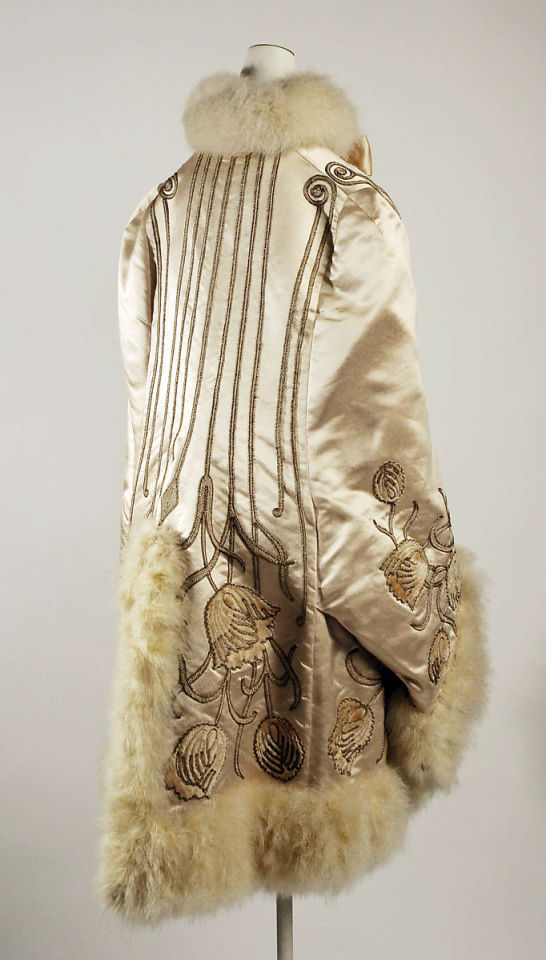
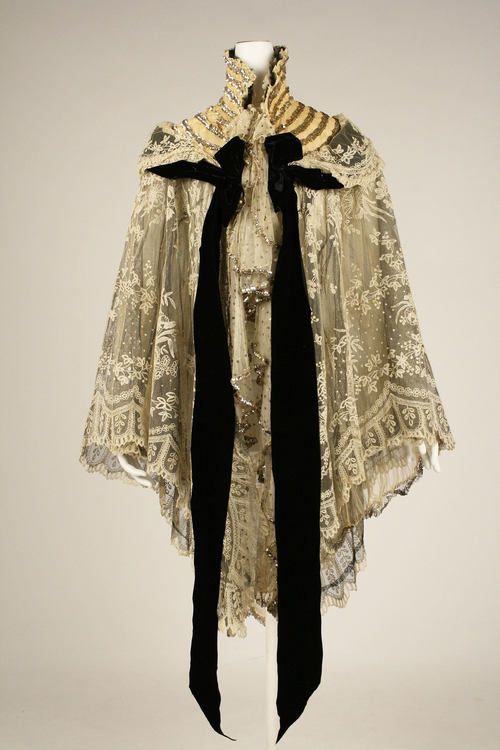
“Well-dressed as well as handsome ladies are looked for in the audience of an opera, and it is out of harmony with the scene and surroundings to see sombre draperies, heavy bonnets, and dull faces. Ladies are supposed to be seen, as well as to see, and are often the most beautiful part of the display. They should not spoil the beauty of the auditorium by wrapping themselves in cloaks or shawls.” -The Art of Dressing Well

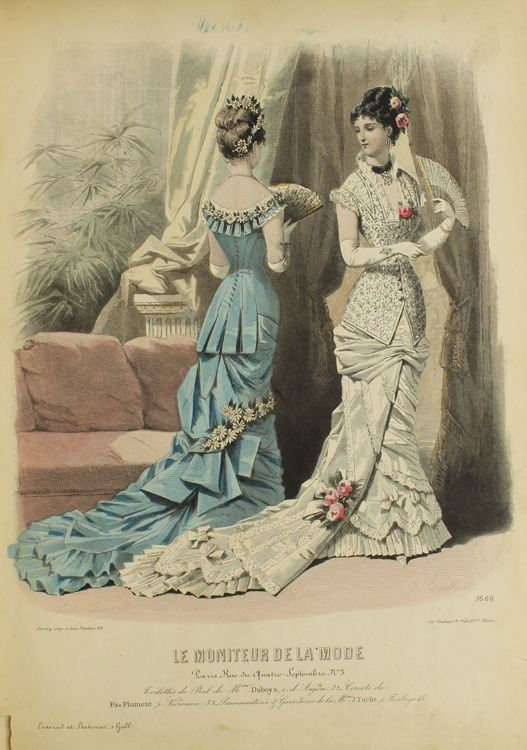


* Sorry, not all sources are cited, as I lost track by not keeping notes.
Part I is here.
#fashion history#victorian fashion#victorian opera clothing#women's formal wear#opera cloak#james tissot#art history#painting#art#victorian fashion plates#french artist#paris fashion#1880s formal fashion#the resplendent outfit blog#high society genre painting#fine art#19th century european art
32 notes
·
View notes
Text

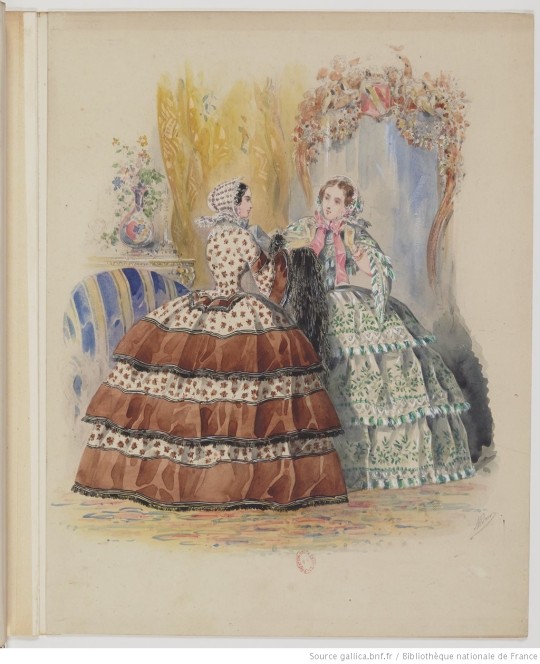



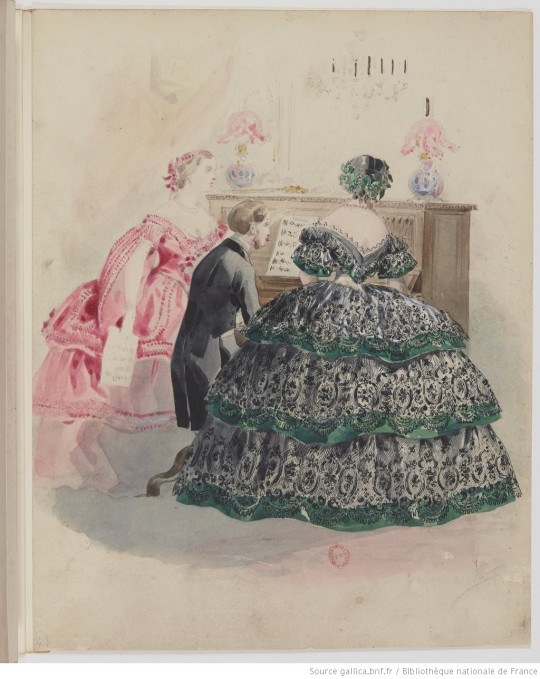

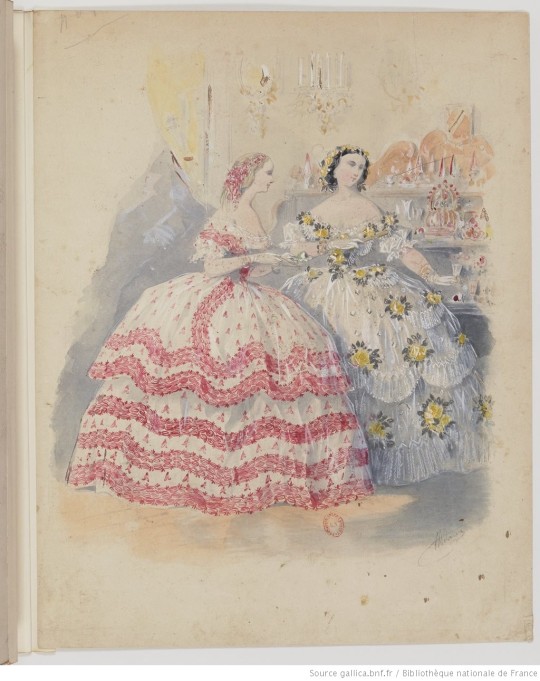
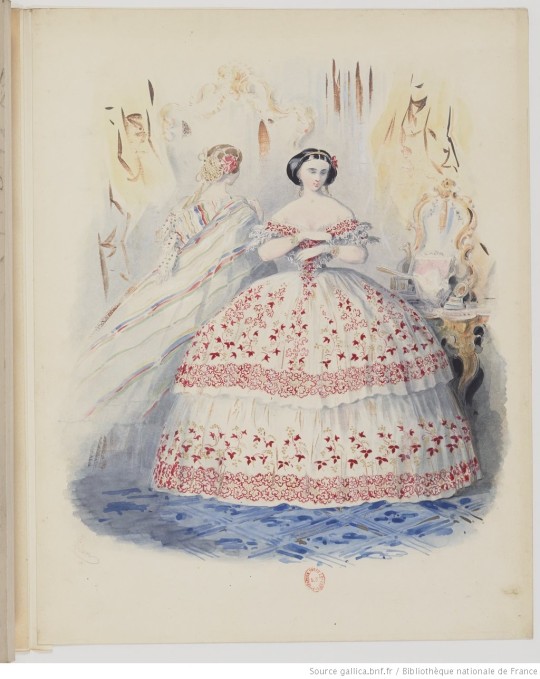

Dessins originaux des Modes, 1858-1865 by Albert Adam, Hippolyte Pauquet.
Bibliothèque nationale de France.
76 notes
·
View notes
Photo
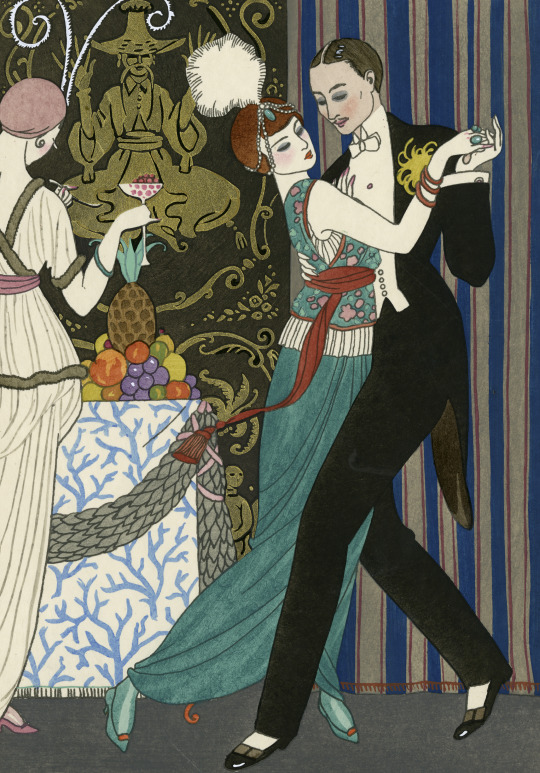
La Danse = The Dance
George Barbier (French; 1882–1932)
Pl. XI in Modes et Manières d'Aujourd’hui (1914)
Pochoir print
FIT Gladys Marcus Library, Special Collections & College Archives, New York
Je suis beau. Mon corps maigre que vêt une ample robe d’or s’incruste dans le panneau de laque noir….. (I am beautiful. My lean form, clothed in a loose golden dress, blends into the black lacquer panel…..)
#hair ornaments#tuxedos#eveningwear#George Barbier#Barbier#Art Deco#pochoir#French illustrators#French illustration#fashion illustration#fashion illustrators#French art#Modes et Manières d'Aujourd'hui#French artists#French Art Deco#Art Deco style#fashion plates#1910s#French fashion#pochoir prints#fashion#fashion magazines#fashion journals#French style#French chic#nightlife#dancers#dancing#dance#couples
58 notes
·
View notes
Text
im so happy and pumped because yesterday morning i finally got around to hang up my 19th century fashion plates!

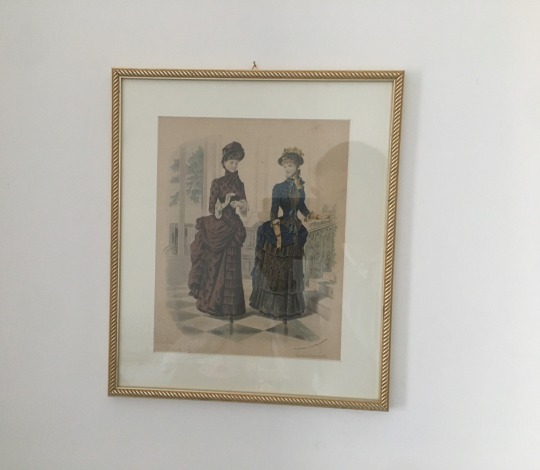
heres some close ups, albeit with some glare

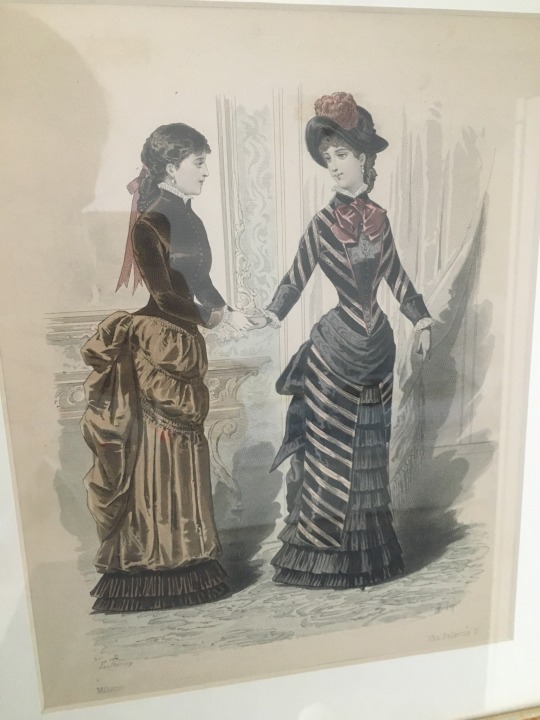
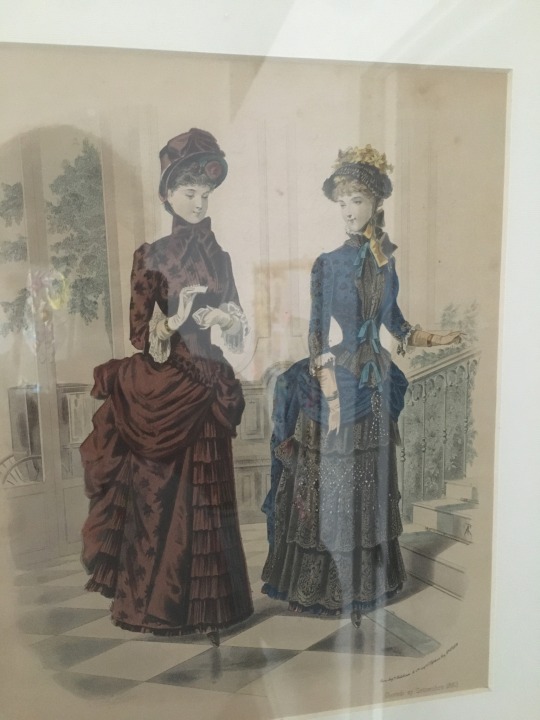
they’re all explicitly dated to september 1883 and from actual italian periodicals! i got them all the way back last june at a monthly antique market, and i love them to bits
#i also got an 1850s french fashion plate alongside these three but there was no more room on the walls#only 30€ for all four of them!!!#its cuz the three above had damaged/broken frames hence the discount#reframing them was the real expense but my mom chipped in and i daresay it was quite worth it#grimm speaks#historical dress
6 notes
·
View notes
Text
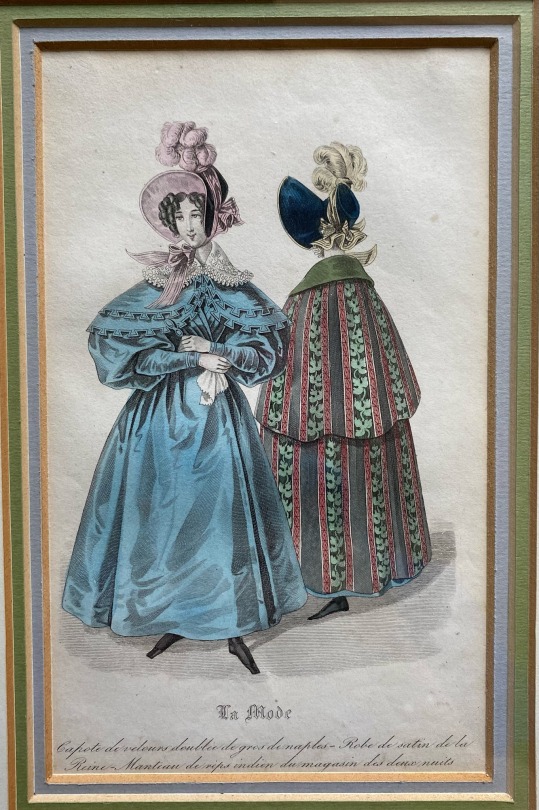
Here is the first of the pair of plates that started my collection. I found them at an estate sale, already framed with these matching mats. Whoever owned them before me clearly loved them. They are from the 1830s and in very good condition. I will post its other half shortly.
The text reads:
La Mode
Capote de velours double de gros de naples- Robe de satin de la Reine-Manteau de rèps indien du magasin des deux nuits.
In English: (I couldn’t figure out what ‘rèps’ means)
The Fashion
Double velvet hood wholesale of (from) Naples- Satin dress of the Queen-Raincoat from the Indian store of the two nights.
A note on translation: yes, ‘capote’ is used to mean ‘condom’ these days, but literally it means ‘hood’.
[Image ID: a framed fashion plate with two models and two frame mats, one blue and one green. The woman on the left faces the viewer. She wears a pink bonnet with four large pink feathers in the center trimmed with a stripped pink ribbon. Her temple curls peak out of the brim. She has a wide, square-shaped collar of white lace. Her dress cornflower blue with large sleeves puffed until the elbow and v-shaped pleats on the bodice. It has a small matching shoulder cape or shawl with an edge of trapezoidal cutouts.
The second woman is turned away from the viewer, her fave hidden by a bonnet of the same type as before, but dark blue with white trimming. She wears a grey two-tiered cape with a green collar and striped with two thin red bands with a green ivy pattern between.]
#fashion history#historical fashion#fashion#image#fashion plates#image id#1830s fashion#1830s#fashion plate#victorian fashion#early Victorian#womenswear#armature translation#french translation
79 notes
·
View notes
Photo

La Mode illustrée, no. 8, 24 février 1862, Paris. Noble matron française de la cour. Costumes anciens et modernes de César Vecellio. Ville de Paris / Bibliothèque Forney
Ces matrones s'habillent avec un grand luxe. Outre une infinité d'ornements d'or, de pierres précieuses, de perles, de chaînes et de colliers, elles disposent leurs vêtements de manière à donner de l'ampleur aux épaules, en laissant la poitrine large et découverte. Le corsage est élégant et richement orné. Leurs robes, le plus souvent, sont de soie à couleurs variées, et tissues d'or; la chemisette est en dentelle finement empesée, soutenue par des fils d'archal, très-légers; la robe de dessus est beaucoup plus courte, plus étroite, que lit robe de dessous, et relevée sur les côtés; cette robe est généralement de couleur unie, en velours, ou bien en soie.
Noble French matron of the court.
These matrons dress with great luxury. Besides an infinity of ornaments of gold, precious stones, pearls, chains and necklaces, they arrange their clothes in such a way as to give fullness to the shoulders, leaving the chest wide and uncovered. The bodice is elegant and richly embellished. Their dresses, most often, are of silk of various colors, and woven with gold; the chemisette is of finely starched lace, supported by very light archal threads; the top dress is much shorter, narrower, than the bottom dress, and raised at the sides; this dress is usually solid color, velvet, or silk.
#la mode illustrée#19th century#1800s#1860s#1862#periodical#fashion#fashion plate#retouch#costume#masquerade#history#description#Forney#Vecellio#dress#noble#french#court#collar#panniers
50 notes
·
View notes
Text
Women’s Hairstyles during the First French Empire
1800-1804:

1804-1807:

1807-1811

1812-1815
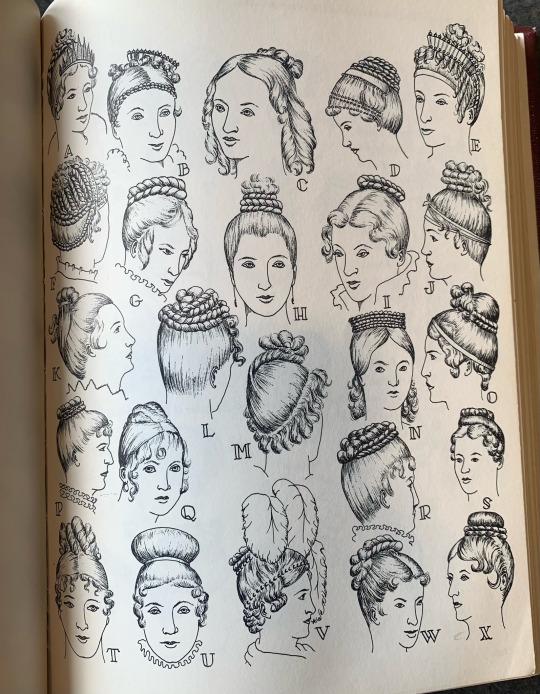
Top row 1815:

Book: Fashions in Hair, by Richard Corson
#fashion plate#hairstyles#fashion plates#hair#women’s hairstyles#fashion history#history#Napoleonic era#napoleonic#first french empire#19th century#1800s#french empire#France#French fashion#fashion#pic#my pic#book#book pic#historical fashion#history of fashion
118 notes
·
View notes
Text

French School. Guests arriving for New Years Eve, fashion plate from Art, Goût, Beauté: Feuillets d' Élégance Feminine (Feminine Elegance Sheets), English Edition, published by Éditions d' Art. Print. Paris, France, 1923
For sale: meisterdrucke
#french school#1923#illustration#fashion plate#vintage#art#1920s#art deco#fashion illustration#paris#chic#parisian chic#parisian fashion#fashion#Art Goût Beauté#Éditions d' Art#New Years Eve#new year#party#1920s party#jazz age#the roaring twenties#20s party#guests#party guests#Feminine Elegance#elegance#yellow#happy new year#happy new year 2024
86 notes
·
View notes
Text
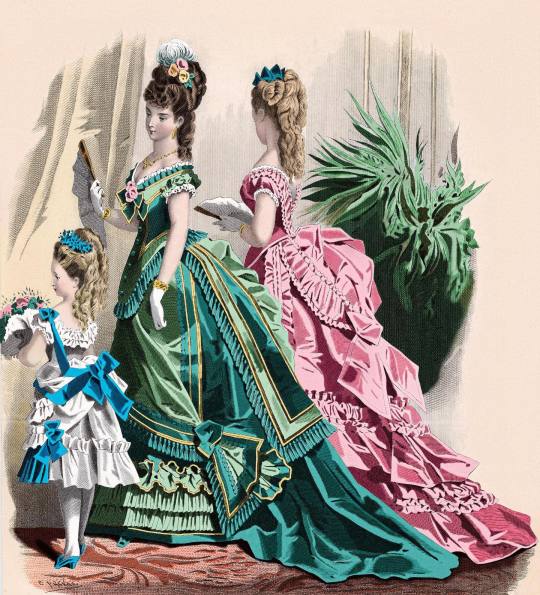
The Englishwoman’s Domestic Magazine, January 1875
via pastlivesfinery
114 notes
·
View notes
Text
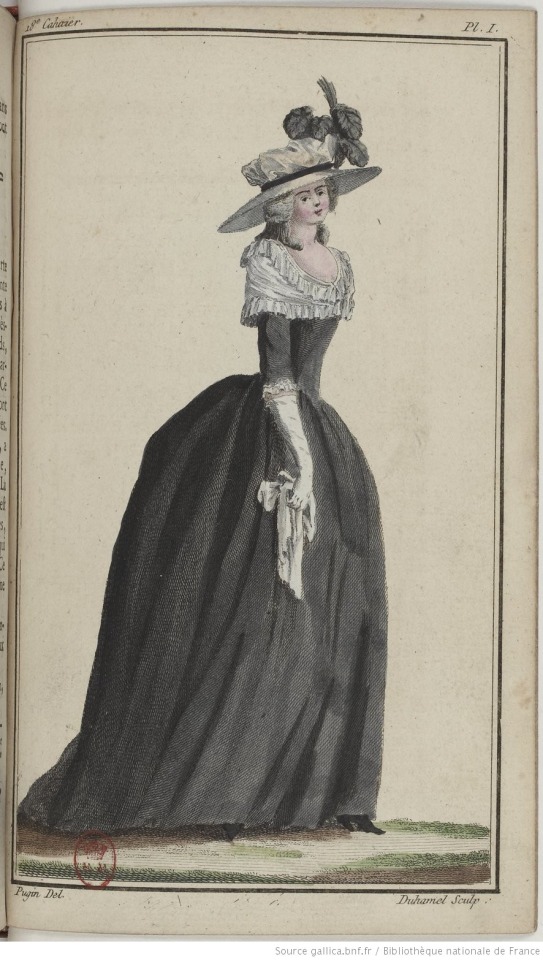
Fashion Plate, 1786, French.
From Cabinet des modes.
Portraying a woman in a black taffeta mourning dress.
BNF Gallica.
#womenswear#france#french#fashion plate#1780s#1780s fashion plate#dress#1780s dress#1786#cabinet des modes#bnf gallica#mourning dress#1780s mourning#mourning#reign: louis xvi
66 notes
·
View notes